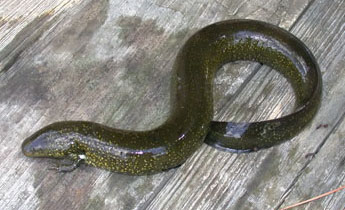Greater Siren (Siren lacertina)



Photos by J.D. Willson unless otherwise noted
| Description: Greater sirens are large, eel-like, salamanders with two forelimbs, external gills and a flattened tail. Although they can approach a full meter in length, most adults are 50-70 cm total length. They vary in coloration throughout their range but are generally an olive green or grayish color with yellow or green flecking along their sides and dorsum. Smaller greater sirens can be differentiated from sympatric lesser sirens by counting the number of costal grooves between the armpit and anus. Greater sirens typically have 36-40 costal grooves while lesser sirens have 31-35 costal grooves. Amphiuma, while superficially similar in appearance, have a round tail, lack external gills and have four reduced “limbs” that are much less developed than the forelimbs of Siren.
Range and Habitat: Greater siren are found along the Atlantic and Gulf Coastal Plains from Virginia south through Florida and west to parts of eastern Alabama. Disjunct populations may exist in parts of Southern Texas and Mexico along the Rio Grande river valley but further genetic investigation is required to determine their identity. The greater siren uses a wide variety of wetlands but is found most often in slow or still bodies of water that are heavily vegetated with a thick layer of organic muck or mud. Because of their ability to aestivate for years at a time (one lab specimen aestivated for 5.2 years), greater siren can thrive in seasonal wetlands. Habits: Breeding activity has been observed in February and March and fertilization is presumed to be external, however the exact mechanism of breeding has yet to be documented. Greater siren occasionally give off a “yelping” sound when handled that is likened to the distant call of green treefrogs (Hyla cinerea) or young ducks. Clicking sounds have also been reported for Siren lacertina. They feed on many different invertebrates and occasional aquatic vertebrates with a possible preference for snails and other mollusks in some areas. Captives can live up to 25 years but no longevity information for wild animals is available. Conservation status: The greater siren is considered common but is patchily distributed along the periphery of its range. There is not much data available for the population status of Siren lacertina across its entire range. Pertinent references: Petranka, J. W. 1998. Salamanders of the United States and Canada. Smithsonian Institution Press. Washington, DC. Sorensen, K. 2004. Population characteristics of Siren lacertina and Amphiuma means in North Florida. Southeastern Naturalist 3:249-258. |
